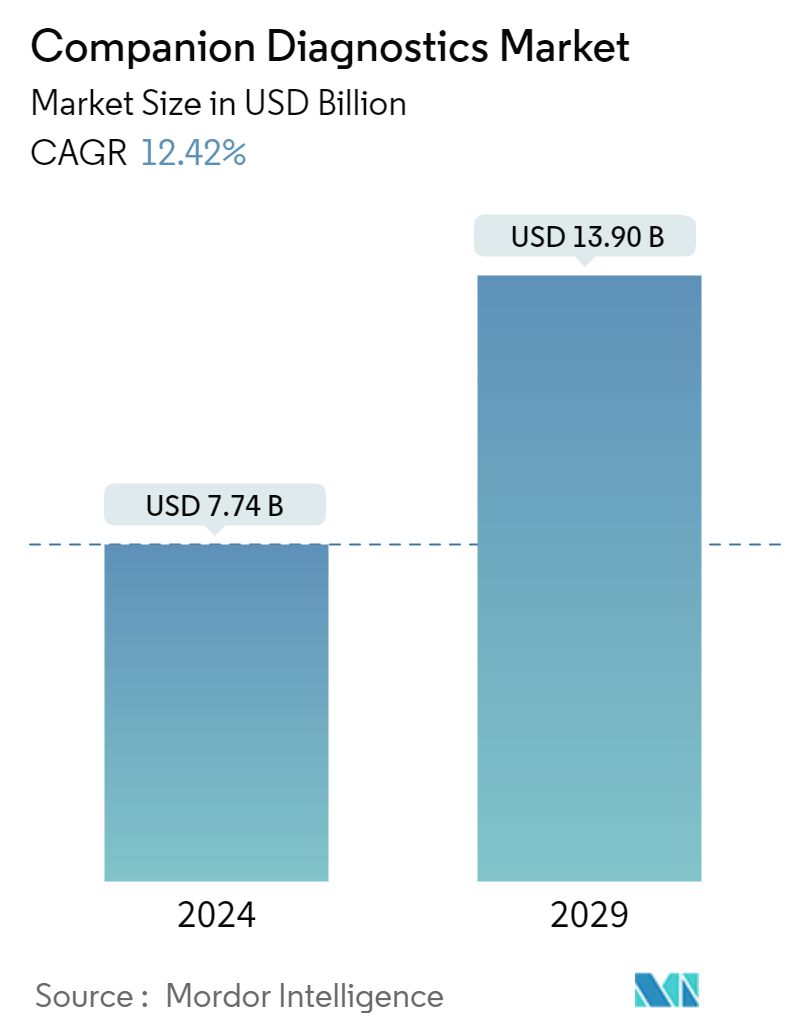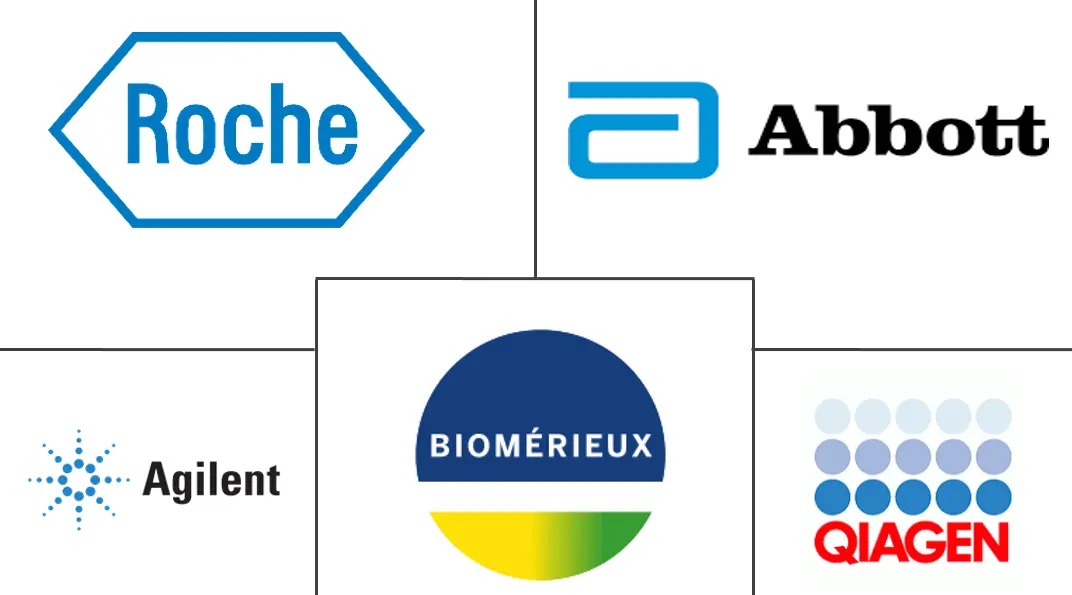Market Size of Companion Diagnostics Industry

| Study Period | 2019 - 2029 |
| Market Size (2024) | USD 7.74 Billion |
| Market Size (2029) | USD 13.90 Billion |
| CAGR (2024 - 2029) | 12.42 % |
| Fastest Growing Market | Asia-Pacific |
| Largest Market | North America |
Major Players
*Disclaimer: Major Players sorted in no particular order |
Companion Diagnostics Market Analysis
The Companion Diagnostics Market size is estimated at USD 7.74 billion in 2024, and is expected to reach USD 13.90 billion by 2029, growing at a CAGR of 12.42% during the forecast period (2024-2029).
The promotion of personalized medicine and targeted therapy as a new treatment option by key players, increasing cases of adverse drug reactions, and the development of new drug and diagnostic technology are expected to boost the market’s growth over the forecast period.
The increasing focus on personalized medicine product approvals and new technology development is propelling the market’s growth. For instance, according to an article published by Healthcare Radius in January 2023, companion diagnostics were observed to be integral to the rising focus on personalized medicine, enabling targeted treatment by identifying specific genetic markers associated with diseases. Their role in co-developing drug and diagnostic technologies ensures a synergistic approach to treatment, maximizing efficacy and minimizing adverse effects. Thus, the benefits offered by companion diagnostics are expected to increase their adoption for treating cancer patients globally.
The increasing cases of adverse drug reactions due to medication inefficacy also drive the need for companion diagnostics in the market, thus aligning therapeutic approaches with patients' genetic profiles to optimize treatment outcomes. For instance, according to an article published by Healthcare Radius in January 2023, companion diagnostics offer a strategic approach to mitigate the potential risks associated with drug treatments and help effectively identify patients predisposed to experiencing adverse effects during therapy. This targeted identification enhances patient safety and optimizes treatment outcomes, thus aligning with medical and business objectives within the healthcare industry. Companion diagnostics can help physicians adjust the dosage or switch to a different treatment option, thus improving patients' overall quality of life.
The rising burden of cancer increases the demand and awareness for personalized medicines among the population globally. For instance, according to the report published by the American Cancer Society in January 2024, about 2 million new cancer cases are projected to be diagnosed in the United States in 2024, compared to 1.9 million cases in 2023. Additionally, according to the report by Red Española de Registros de Cáncer published in January 2023, the incidence rate of cancer cases estimated in Spain for 2023 was 279,260. Clinical diagnostics are integral to implementing personalized medicine, thus leveraging individuals' genetic profiles to enhance precision and efficacy in cancer treatment. This approach ensures tailored strategies that align with specific patient needs, fostering optimal outcomes within oncology care.
Companies are strategically enhancing collaborations to advance biomarkers and diagnostic technologies, particularly focusing on cost efficiency and regulatory compliance. This trend has generated numerous opportunities for diagnostic applications in critical medical indications such as cancer, cardiovascular diseases, and neurological disorders. For instance, in January 2024, Agilent Technologies Inc. signed an agreement with Incyte, bringing together Agilent’s expertise in developing companion diagnostics (CDx) to support the development and commercialization of Incyte’s hematology and oncology portfolio. This agreement allows Agilent to expand its companion diagnostics portfolio with novel biomarkers.
Major companies are actively advancing innovative technologies and formulating strategic growth plans to tackle a broader range of unmet needs in cancer care. For instance, in October 2023, Foundation Medicine Inc. received approval from the US Food and Drug Administration for FoundationOneCDx and FoundationOneLiquid CDx to be used as companion diagnostics for Pfizer’s BRAFTOVI (encorafenib) in combination with MEKTOVI (binimetinib) for the treatment of adult patients with metastatic non-small cell lung cancer (NSCLC) with a BRAF V600E mutation.
In February 2023, Roche signed a collaboration with Janssen Biotech Inc. (Janssen) to create companion diagnostics for targeted therapies, further strengthening research and innovation activities.
Thus, the increasing promotion of personalized medicine and targeted therapy by key players, rising cases of adverse drug reactions, and the development of new drug and diagnostic technologies are impacting the companion diagnostics market’s growth. However, the high cost of drug development and associated clinical trials and reimbursement issues among many countries are expected to restrain the market over the forecast period.
Companion Diagnostics Industry Segmentation
As per the scope of the report, companion diagnostic tests provide information essential for safely and effectively using a corresponding drug or biological product.
The companion diagnostics market is segmented by technology, indication, and geography. The technology segment is divided into immunohistochemistry (IHC), polymerase chain reaction (PCR), in-situ hybridization (ISH), real-time PCR (RT-PCR), gene sequencing, and other technologies. The indication segment is divided into lung cancer, breast cancer, colorectal cancer, leukemia, melanoma, and other indications. The report also covers the estimated market sizes and trends for 17 countries across major regions globally. The report offers the value in USD for these segments.
| By Technology | |
| Immunohistochemistry (IHC) | |
| Polymerase Chain Reaction (PCR) | |
| In-situ Hybridization (ISH) | |
| Real-time PCR (RT-PCR) | |
| Gene Sequencing | |
| Other Technologies |
| By Indication | |
| Lung Cancer | |
| Breast Cancer | |
| Colorectal Cancer | |
| Leukemia | |
| Melanoma | |
| Other Indications |
| By Geography | ||||||||
| ||||||||
| ||||||||
| ||||||||
| ||||||||
|
Companion Diagnostics Market Size Summary
The companion diagnostics market is poised for significant growth, driven by the increasing emphasis on personalized medicine and targeted therapies. This market expansion is fueled by advancements in drug and diagnostic technologies, which are integral to enhancing treatment efficacy and minimizing adverse drug reactions. The role of companion diagnostics in identifying specific genetic markers is crucial for developing tailored treatment strategies, particularly in oncology. As the burden of cancer continues to rise globally, the demand for personalized medicine solutions is expected to increase, further propelling the market. Companies are actively engaging in strategic collaborations and innovations to advance biomarkers and diagnostic technologies, aiming to address unmet needs in cancer care and other critical medical indications.
North America is anticipated to be a key region in the companion diagnostics market, with the United States playing a significant role due to its robust healthcare infrastructure and regulatory support. The increasing incidence of cancer in the region is expected to drive the demand for companion diagnostics, supported by product launches and strategic partnerships. The market is characterized by intense competition among major players, who are focusing on co-development activities and personalized medicine solutions. Despite the high costs associated with drug development and clinical trials, the market is expected to grow, driven by the strategic importance of companion diagnostics in informed treatment decisions and the ongoing advancements in diagnostic technologies.
Companion Diagnostics Market Size - Table of Contents
-
1. MARKET DYNAMICS
-
1.1 Market Overview
-
1.2 Market Drivers
-
1.2.1 Companies Promoting Personalized Medicine and Targeted Therapy as a New Treatment Option
-
1.2.2 Increasing Cases of Adverse Drug Reactions
-
1.2.3 Co-development of Drug and Diagnostic Technologies
-
-
1.3 Market Restraints
-
1.3.1 High Cost of Drug Development and Associated Clinical Trials
-
1.3.2 Reimbursement Issues Among Many Countries
-
-
1.4 Industry Attractiveness - Porter's Five Forces Analysis
-
1.4.1 Threat of New Entrants
-
1.4.2 Bargaining Power of Buyers/Consumers
-
1.4.3 Bargaining Power of Suppliers
-
1.4.4 Threat of Substitute Products
-
1.4.5 Intensity of Competitive Rivalry
-
-
-
2. MARKET SEGMENTATION (Market Size by Value in USD)
-
2.1 By Technology
-
2.1.1 Immunohistochemistry (IHC)
-
2.1.2 Polymerase Chain Reaction (PCR)
-
2.1.3 In-situ Hybridization (ISH)
-
2.1.4 Real-time PCR (RT-PCR)
-
2.1.5 Gene Sequencing
-
2.1.6 Other Technologies
-
-
2.2 By Indication
-
2.2.1 Lung Cancer
-
2.2.2 Breast Cancer
-
2.2.3 Colorectal Cancer
-
2.2.4 Leukemia
-
2.2.5 Melanoma
-
2.2.6 Other Indications
-
-
2.3 By Geography
-
2.3.1 North America
-
2.3.1.1 United States
-
2.3.1.2 Canada
-
2.3.1.3 Mexico
-
-
2.3.2 Europe
-
2.3.2.1 Germany
-
2.3.2.2 United Kingdom
-
2.3.2.3 France
-
2.3.2.4 Italy
-
2.3.2.5 Spain
-
2.3.2.6 Rest of Europe
-
-
2.3.3 Asia-Pacific
-
2.3.3.1 China
-
2.3.3.2 Japan
-
2.3.3.3 India
-
2.3.3.4 Australia
-
2.3.3.5 South Korea
-
2.3.3.6 Rest of Asia-Pacific
-
-
2.3.4 Middle East and Africa
-
2.3.4.1 GCC
-
2.3.4.2 South Africa
-
2.3.4.3 Rest of Middle East and Africa
-
-
2.3.5 South America
-
2.3.5.1 Brazil
-
2.3.5.2 Argentina
-
2.3.5.3 Rest of South America
-
-
-
Companion Diagnostics Market Size FAQs
How big is the Companion Diagnostics Market?
The Companion Diagnostics Market size is expected to reach USD 7.74 billion in 2024 and grow at a CAGR of 12.42% to reach USD 13.90 billion by 2029.
What is the current Companion Diagnostics Market size?
In 2024, the Companion Diagnostics Market size is expected to reach USD 7.74 billion.

